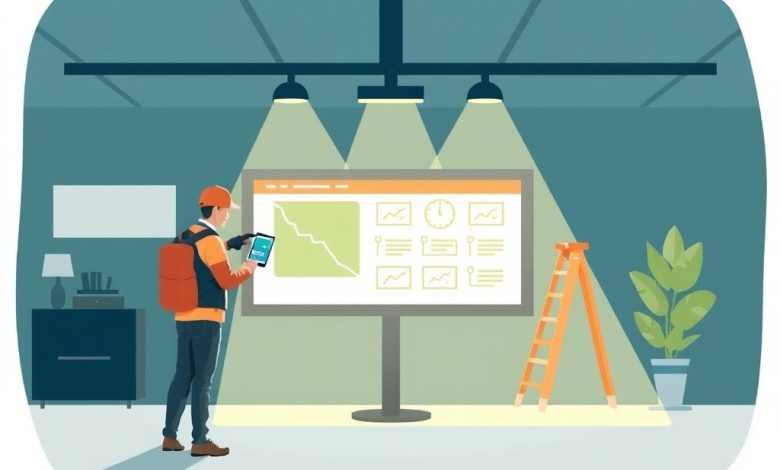Field Service Management for Indoor Positioning Leveraging BLE and RFID Technologies

Field Service Management for Indoor Positioning: Leveraging BLE and RFID Technologies
Introduction
In today’s fast-paced business environment, efficient field service management is crucial for companies operating in various industries. The integration of indoor positioning technologies such as Bluetooth Low Energy (BLE) and Radio Frequency Identification (RFID) has revolutionized the way field service operations are managed. This article explores the concept of field service management for indoor positioning, focusing on the use of BLE and RFID technologies.
What is Field Service Management?
Field service management refers to the processes and systems used to manage and coordinate work performed outside the office environment. It encompasses activities such as scheduling appointments, dispatching technicians, managing inventory, and tracking customer interactions. Effective field service management is essential for maintaining high levels of customer satisfaction while optimizing operational efficiency.
The Role of Indoor Positioning in Field Service Management
Indoor positioning technology plays a significant role in enhancing field service management operations. By providing accurate location data within indoor environments, these technologies enable more efficient route planning, real-time tracking, and improved communication between field workers and dispatchers.
Benefits of Indoor Positioning for Field Service Management
- Improved Accuracy in Location Tracking
- BLE and RFID technologies offer precise indoor positioning capabilities, eliminating the need for GPS signals which may not penetrate through building structures effectively.
- This accuracy enables better estimation of job duration and resource allocation.
2. Enhanced Route Optimization
- With real-time location data, dispatchers can create optimized routes for field workers, reducing travel time and improving overall efficiency.
- This feature is particularly beneficial in large facilities such as hospitals, shopping malls, or office complexes.
3. Increased Productivity
- By providing workers with real-time location data, they can navigate through unfamiliar areas more easily, leading to increased productivity and reduced downtime.
- This feature also helps in identifying potential bottlenecks in service delivery processes.
4. Improved Customer Experience
- Real-time tracking allows field service managers to provide accurate estimated arrival times to customers, enhancing transparency and reducing customer frustration.
- This feature also enables managers to proactively address any delays or issues that may arise during service delivery.
BLE Technology in Field Service Management
Bluetooth Low Energy (BLE) technology has emerged as a powerful tool for indoor positioning in field service management. Its low power consumption and ability to operate within crowded radio frequency environments make it an ideal choice for indoor applications.
How BLE Works in Indoor Positioning
- Beacon Deployment
- Small BLE beacons are strategically placed throughout the facility to create a network of location-aware points.
- These beacons continuously transmit unique identifiers at regular intervals.
2. Device Detection
- Field workers' mobile devices equipped with BLE receivers detect these signals and report them back to a central server.
- The server then calculates the device's position based on signal strength and time delay.
3. Real-time Tracking
- Once the system is set up, it provides real-time location data of field workers within the facility.
- This data can be visualized on maps or dashboards for easy interpretation by managers.
Advantages of BLE in Field Service Management
- Cost-effective solution compared to traditional GPS-based systems
- No need for complex infrastructure setup
- High accuracy in indoor environments
- Long battery life of beacons reduces maintenance costs
RFID Systems in Field Service Management
Radio Frequency Identification (RFID) technology has been used in various industrial settings for inventory tracking and asset management. In the context of field service management, RFID systems offer similar advantages with some additional features.
How RFID Works in Indoor Positioning
- Tag Deployment
- RFID tags containing unique identifiers are attached to assets or personnel within the facility.
- These tags respond to reader signals with their identification data.
2. Reader Setup
- RFID readers are installed at strategic locations throughout the facility to cover the entire area.
- They continuously scan for nearby tags and send the data to a central server.
3. Data Processing
- The server processes the received data to determine the location and status of tagged items or personnel.
- This information is then integrated into the field service management system.
Advantages of RFID in Field Service Management
- Ability to track multiple items simultaneously
- Longer read range compared to BLE, reducing the number of readers needed
- Durability of RFID tags allows for long-term use without frequent replacement
- Potential for passive RFID tags to reduce power consumption and extend battery life of mobile devices
Challenges and Considerations
While BLE and RFID technologies offer significant benefits for field service management, there are several challenges that need to be addressed:
- Initial Setup Costs
- Deploying a comprehensive indoor positioning system requires significant investment in hardware and software.
- The cost-benefit analysis should consider the scale of operations and expected improvements in efficiency.
2. Privacy Concerns
- Continuous tracking of employees raises privacy concerns that must be addressed through clear policies and user consent mechanisms.
- Employees should have control over their personal data and be able to opt-out of tracking if desired.
3. Interference Issues
- In densely populated areas, interference from other wireless devices can affect the accuracy of positioning data.
- Regular monitoring and optimization of the system are necessary to maintain high levels of accuracy.
4. Integration with Existing Systems
- Seamless integration with existing field service management software is crucial for maximizing the benefits of indoor positioning.
- API compatibility and data exchange protocols should be carefully considered during system design.
Conclusion
Field service management for indoor positioning using BLE and RFID technologies represents a significant advancement in operational efficiency. By providing accurate location data and enabling real-time tracking, these systems allow field service managers to optimize routes, improve productivity, and enhance customer satisfaction.
As the technology continues to evolve, we can expect further improvements in accuracy, scalability, and ease of implementation. However, it’s important for organizations to carefully consider the challenges and implement appropriate measures to address them.
For businesses operating in large facilities or those looking to streamline their field service operations, investing in indoor positioning technology could be a game-changer. It not only improves operational efficiency but also contributes to overall business success in today’s competitive market.




